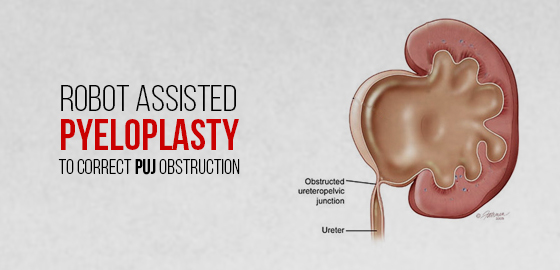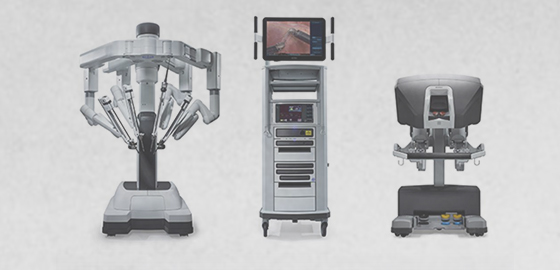Robotic pyeloplasty
Robot assisted laparoscopic pyeloplasty
What is Pyeloplasty?
A pyeloplasty is an operation to correct a PEU obstruction, where the tube connecting the kidney to the bladder (bladder) is narrowed at its junction with the kidney and does what? Which helps the kidney to drain properly and hence enhances its function.
How is it done?
The operation can be performed by the well-known open approach or keyhole surgery and can be done with or without robotic assistance.
What is the open pyeloplasty procedure?
Open pyeloplasty is a surgery in which a surgeon drains your kidney using a 12-18 cm incision to improve kidney function.
What is Robotic Assisted Surgery?
This is a technique where a robotic console is placed next to you. 3 robotic arms are attached to the console; Two are for instrument attachment and the other arm is for a high-magnification 3D camera so the surgeon can see your abdomen(s). The two robotic arms have the ability to hold various instruments attached to them to help the surgeon perform your operation. Width of devices is about 7 mm.
Machines have a greater range of motion than human hands; And because of their size and ability to see operations in trinity; It helps the surgeon to operate in a smaller space.
Previous surgeons made larger holes to be able to perform most operations. Robotic surgery involves inserting robotic arms into your abdomen through small incisions in your abdomen; The surgeon sits in the same room but away from the patient, and with a surgeon at the patient's side of the bed, using robotic assistance is able to make more controlled and precise movements.
Benefits:
- Open surgery and does not result in large wounds
- Significantly less bleeding
- Precise surgery results in good results
- Pain after surgery is reduced.
- A short hospital stay is required.
- Faster full recovery and shorter return to work.
What are the risks of the procedure?
As with any surgery there are some risks, the most common of which are:
- During piercing: Bleeding, damage to internal structures of the abdomen (abdominal) – this is minimized by placing the piercing under vision.
- During operation: bleeding, conversion to open surgery, injury to abdominal structures
- During evacuation from stomach: bleeding
- After surgery: Bleeding, infection, hernia at the incision site, blood clots in the leg that may change, pain in the side of the shoulder.
- Leakage of urine at the junction of the kidney with the ureter usually resolves on its own.
Do robots perform surgery?
No, the surgeon operates. A robot is a device that helps surgeons to operate in small areas of the body. It essentially transforms the surgeon's hand into two seven-millimeter instruments. The robot is controlled by the surgeon but never operates on its own.
How much will I suffer?
Because the surgery is performed through a small incision, most patients experience much less discomfort than with open surgery. Patients require far less pain medication. After a week, most feel no pain. Also, the risk of post-operative hernias is reduced.
When can I exercise?
A small amount of walking is encouraged immediately after the procedure. After 2 weeks, jogging and aerobic exercise are allowed. After four weeks, heavy lifting can be resumed.
Why is a pyeloplasty operation performed?
A pyeloplasty is done to cure the condition where the tube that takes urine from the kidney and into the bladder is obstructed, causing the urine to flow back into the kidney. If not treated at the proper time, it may result in infections, pain, and a reduction in renal function. Pyeloplasty surgery can aid in addressing these problems and prevent them from recurring or getting worse.
A pelviureteric junction (PUJ) obstruction can be primary since birth or secondary or acquired. In primary PUJO, a adynamic segment of ureter or rarely a crossing vessel can result in a narrowing that obstructs the flow of urine. Secondary causes include stones, Reflux disease, benign strictures, malignancy. Ultrasounds and other imaging tests like a CT Urogram or a Nuclear scan called as Renogram can be done to determine the cause of the obstruction and whether surgery is required or not. Significant obstruction, deteriorating function and pain are the usual indications for a pyeloplasty.
Robotic Pyeloplasty
Robotic pyeloplasty is a minimally invasive procedure that boosts a urologist’s abilities by employing a mix of HD 3D magnification, robotic technology, and freedom of movement comparable to the human wrist.
In contrast to an open pyeloplasty, which normally necessitates a major abdominal incision and retraction to make room for human hands, a robot-assisted pyeloplasty only necessitates a minor incision to fit the robotic arms and surgical instruments. Four arms are accessible where two serve as the surgeon's arms, a fourth arm is employed to hold back tissue, and one is outfitted with a high-resolution 3-D magnifying camera. The surgeon can see more detail, a real depth of field, and a panoramic picture thanks to the camera, and the robotic hands' wide range of motion furnishes more proficiency and accuracy, which are essential for reconstructive procedures of the urinary system. While settled at the console, a short stretch from the patient, the surgeon controls the robotic arms remotely and efficiently.
Benefits of Robotic Pyeloplasty Surgery:-
- Less bleeding
- Minimum scarring
- Minimum medication and post-operative discomfort
- Faster healing and resumption of regular activities
We at World of Urology have experienced urologists with expertise in robotic urologic surgeries. Our affiliated surgeons have successfully completed numerous difficult pyeloplasty procedures including re-do procedures with a good success rate. The art is not knowing how to cut but when to cut and with the right investigative modalities we ensure whether surgery is really required or not.
Doctors
Services
- RAVH
- Robotic Pyeloplasty
- Sacral Colpopexy
- Robotic Radical Prostatectomy
- Penile Prosthesis
- Kidney Transplant
- Urinary Incontinence Treatment
- Nephron Sparing Surgery
Address: No 156, Orchard Grande, 4 th Cross, 8th B-Main Sadashivanagar, Bangalore 560080
Location:- https://goo.gl/maps/oVgbWK1gDSkEkm5i6
visit are blog: https://www.worldofurology.in/blog
resources URL: https://www.worldofurology.in/
Twitter: https://twitter.com/worldofurology
Facebook: https://www.facebook.com/WorldUro/
Instagram:- https://www.instagram.com/worlduro/
Linkedin:- https://www.linkedin.com/company/world-of-urology/






Comments
Post a Comment